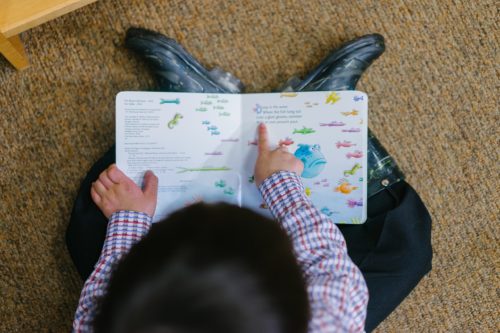Two of the most common types of learning texts used when teaching students how to read are decodable books and leveled books. These two types of texts represent two different approaches to teaching, and today we will take a look at the differences between the two, as well as the pros and cons of each type of text.
Main difference : Decodable books are written with controlled phonics patterns in mind, while leveled books are dictated by the difficulty of vocabulary and sentence patterns
Our last blog provides a comprehensive overview of decodable texts, but simply put, they are texts written with a specific phonetic pattern throughout the whole text. The phonetic patterns used are by default ones that the students have already learned–meaning that texts are written with a controlled word list to ensure that it does not include difficult words that students cannot decode with their phonics skill.
Leveled books, on the other hand, are characterized by the difficulty of word knowledge, vocabulary, and sentence structure. They do not take into consideration the phonetic ability of the student and includes a mix of easy and complex words. They are often characterized by a “predictable” text in which it is possible for student to use context or illustrations to guess at the words.
How each of these two texts benefit learners: Decodable readers are an excellent tool to help students improve their reading ability:
- Offer an effective way for students to practice and consolidate their phonics skills
- Promote reading fluency and accuracy
- Help boost students’ confidence as they are able to read decodable texts independently using their own knowledge and skills
Leveled readers, on the other hand, is known to help promote reading comprehension skills:
- Without word choice limitations, leveled stories are interesting and relatable, which in turn keeps readers more engaged
- The more complex texts allow students to practice and improve reading comprehension skills and help to build vocabulary
- Often paired with beautiful illustrations which help further engage readers
Now let’s take a look at what these two texts are sometimes reproached (rightfully or wrongly) for: Decodables texts have a reputation of being “boring” and not holistic in its teaching approach:
- Since decodables need to be written with a controlled word list, the story lines can be less interesting and sometimes make less sense
- In order to ensure that not too much context is given away, the artwork is often overly simplistic and not colored, which makes the reading experience less interesting and less engaging
- With the main role of decodables being targeted practice of phonics skills, some people find that they do not help learners in other areas such as reading comprehension and vocabulary building
Leveled books are not controlled for phonics patterns, and may cause a number of problems:
- Do not include enough repetition of phonic patterns and thus may not offer effective help with building critical phonics and decoding skills
- By design, leveled books include a high number of challenging words that may be discouraging for young learners when they struggle to decode them
- Readers are likely to resort to guessing at the difficult words that they are unable to decode by using context clues and illustrations, which is a poor reading strategy
So, which of these two texts should we hand to the student?
The simple answer is, both! A combination of these two types of texts which serve different purposes can be a powerful and holistic way to help build successful readers with well-rounded reading skills.
That is why here at Phunics, we strive to offer books that include the best of both worlds. Our leveled and decodable texts are designed in an unique way to provide a fun, effective, and holistic learning experience:
- Our stories are fun! They are written with engaging story lines that “make sense”– learners will feel like they are reading an actual (and fun) book, not doing some phonics practice
- Stories from the same level are designed with themed characters and settings that reappear throughout the entire level; the different stories are thus weaved into one continuous story line, encouraging readers to develop comprehension skills and other reading strategies such as predicting and summarizing
- Vocabulary building is not neglected! A steady vocabulary development is ensured by purposefully incorporating repetitions of high-frequency words and other level-appropriate key vocabulary in the stories, all done in a gradual way so as to not overwhelm learners
- Our stories are beautiful! All of our stories are paired with beautiful illustrations aimed at capturing the reader’s interest, but without giving too much information away to prevent the readers from guessing
Discover the power of our uniquely designed leveled and decodable stories today! The first three stories from each level on our site are free for anyone to enjoy.
Here are a few sample stories to start with:
Pam and the Pan from our level 1 Family Fun series
Sam the Cat from our level 2 Life’s Lessons series
Eve’s Night Lights from our level 5 Zodiac series
Happy reading!
